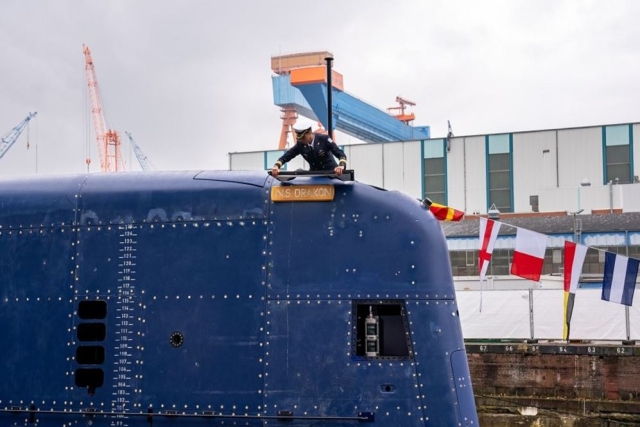INS DRAKON Sub Launched for Israeli Navy, Production of First Dakar Sub Also Begins
A ceremony in Kiel today marked the two events, with guests from both Germany and Israel in attendance.

The Israeli Navy’s INS DRAKON, the third HDW Class Dolphin AIP submarine, was launched earlier today, and production began for the first DAKAR Class submarine for the Israeli Defense Forces.
The launch of INS DRAKON completes the Israeli Navy's HDW Class Dolphin AIP submarine order. The submarine is scheduled to be delivered to the IDF in 2025, after which it will sail to its home port and join its sister vessels as an operational submarine in the Israeli Navy.
INS DRAKON is larger than previous Israeli submarines, with a large sail likely housing advanced missiles. Its extended hull follows the Dolphin-II design, and the upcoming DAKAR class will likely be similar. The sail could accommodate 4-8 smaller missile silos, possibly nuclear-armed, though other uses like Special Forces equipment are less likely. The exact nature of the missiles is secret, but they may be ballistic with a guided final stage. Despite the missile silos, INS DRAKON retains four torpedo tubes for Israeli-developed cruise missiles, which may be nuclear-armed. This suggests the new missiles aren't replacing the cruise missiles, and the vertical launch tubes may have been added late in the design. The submarine’s full capabilities may take years to uncover, with some details remaining secret.
The start of production for the DAKAR submarine continues the ongoing partnership between thyssenkrupp Marine Systems (TKMS) and the Israeli Defense Forces. The Israeli Navy’s DAKAR class submarines will feature a larger sail compared to the Dolphin class and may include a vertical launch system (VLS), expanding strike capacity. Three DAKAR class boats will replace the original Dolphin class submarines, built between 1999 and 2000. TKMS, the contractor, describes the DAKAR class as a new design tailored to Israel's needs. The enlarged sail could provide more mission space for special operations or weapons. While it is unclear if the submarines will carry submarine-launched ballistic missiles (SLBMs), the VLS could accommodate cruise missiles, including potentially hypersonic ones, enhancing Israel’s deterrence. The DAKAR class may also reflect Israel’s desire for greater naval reach and a more robust second-strike capability.










